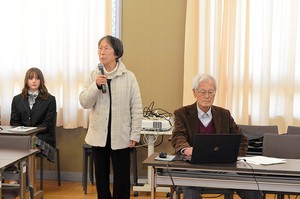By TAICHI KOBAYASHI/ Staff Writer
March 11, 2022 at 19:01 JST
 Tokyo Governor Yuriko Koike reports on the spread of the novel coronavirus and the state of medical services in the capital at a meeting on March 10. (Provided by the Tokyo metropolitan government)
Tokyo Governor Yuriko Koike reports on the spread of the novel coronavirus and the state of medical services in the capital at a meeting on March 10. (Provided by the Tokyo metropolitan government)
Health experts are warning that a subvariant of a novel coronavirus strain could soon take the place of the variant that fueled the sixth wave of infections in Japan.
The Tokyo metropolitan government on March 10 said at a meeting on the pandemic that 12.3 percent of people who underwent PCR tests in the last week of February are suspected to have been infected with the BA.2 subvariant of the Omicron strain.
The Tokyo Metropolitan Institute of Public Health conducts its own PCR tests that can detect mutant strains of the novel coronavirus. Every week, it calculates the percentage of suspected cases of BA.2.
At the meeting, the metropolitan government reported that for the week from Feb. 8 to Feb. 14, only one person was suspected of being infected with BA.2, or 1.3 percent of those tested.
The figure rose to 32, or 8 percent, in the week from Feb. 15 to Feb. 21. For the following week, 19 people, or 12.3 percent, were suspected cases of BA.2.
Other mutant strains of the novel coronavirus started to rapidly take over their predecessors when the rates exceeded 10 percent.
With that in mind, Mitsuo Kaku, chairman of the expert board at the Tokyo Center for Infectious Disease Control and Prevention (Tokyo iCDC), warned that BA.2 could soon possibly take the place of Omicron BA.1. He also told the meeting that people who have been infected with BA.1 could also catch BA.2
The meeting also heard that the daily average of new COVID-19 cases over the week through March 9 in the capital was 9,379.
Norio Oomagari, from the National Center for Global Health and Medicine, pointed out that although the daily average gradually declined over four straight weeks after peaking at 18,025 for the week through Feb. 8, the impact on the medical system in the latest wave remains huge.
He added that residents should remain on guard even though the daily average is expected to fall to 8,254 for the week until March 17.
“Infections could spread again with the increasing opportunities for people to go out and see each other, with the seasonal events held at the end of fiscal year, or also because of a possible rise in BA.2 cases,” he said.




















A peek through the music industry’s curtain at the producers who harnessed social media to help their idols go global.
A series based on diplomatic documents declassified by Japan’s Foreign Ministry
Here is a collection of first-hand accounts by “hibakusha” atomic bomb survivors.
Cooking experts, chefs and others involved in the field of food introduce their special recipes intertwined with their paths in life.
A series about Japanese-Americans and their memories of World War II